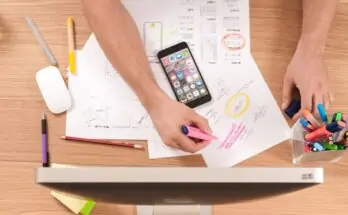Discover How Design Makes Us Think our thoughts and behaviors, exploring the psychology behind it and its impact on decision-making, emotions, and everyday life.
Introduction to Design and Thought
Design is an integral part of our daily lives, influencing how we perceive and interact with the world around us. From the layout of our favorite app to the architecture of our cities, design shapes our experiences and, in turn, our thoughts. This article delves into the fascinating connection between design and cognitive processes, exploring how design makes us think, feel, and act in specific ways.
The Psychology of Design
Understanding Design Psychology
Design psychology examines how design elements affect human behavior and cognition. By understanding the psychological principles behind design, creators can craft experiences that resonate deeply with users. This field blends cognitive psychology, emotional theory, and aesthetic principles to explore how visual and functional elements of design influence our mental processes.
Cognitive Psychology and Design
Cognitive psychology focuses on how people think, learn, and remember. When applied to design, it helps us understand how elements like layout, color, and typography can enhance usability and comprehension. Designers use these principles to create interfaces that are intuitive and easy to navigate, thereby improving user experience.
Emotional Responses to Design
Design isn’t just about functionality; it’s also about evoking emotions. Colors, shapes, and images can trigger emotional responses, which designers harness to create powerful and memorable experiences. Understanding these emotional triggers is crucial for designing products that not only meet functional needs but also resonate on a deeper, emotional level.

Historical Perspectives on Design and Thought
Design in Ancient Cultures
Ancient civilizations used design to communicate ideas, beliefs, and cultural values. From the grand pyramids of Egypt to the intricate patterns of Greek pottery, design has always been a powerful medium for expression and thought.
The Evolution of Design Philosophy
Over centuries, design philosophies have evolved, reflecting changes in society, technology, and thought. Movements like the Renaissance, Baroque, and Modernism each brought new perspectives on how design can influence human thought and behavior.
Design Movements and Their Impact
Design movements have often challenged prevailing norms and introduced innovative ways of thinking. For example, the Bauhaus movement emphasized simplicity and functionality, influencing not only design but also modern architecture, art, and industry.
Cognitive Processes Influenced by Design
Attention and Design
Effective design captures and holds attention. Designers use principles like contrast, alignment, and balance to guide the viewer’s eye and maintain interest. Understanding how attention works helps designers create more engaging and effective visuals.
Memory and Design
Design can aid memory retention by organizing information in a way that’s easy to understand and recall. Techniques like chunking information, using mnemonic devices, and employing consistent visual cues are all ways design can enhance memory.
Perception and Design
Our perception is shaped by the way design elements are presented. Gestalt principles, for example, explain how we tend to perceive visual elements as organized patterns or wholes, rather than just a collection of parts. Designers use these principles to create harmonious and visually appealing compositions.
Emotional Impact of Design
How Design Evokes Emotions
Design elements such as color, typography, and imagery can evoke a wide range of emotions. For instance, warm colors like red and yellow can create feelings of excitement and warmth, while cool colors like blue and green are often calming and serene.
Case Studies of Emotional Design
Looking at successful products like Apple’s iPhone or Tesla’s cars, we can see how design plays a crucial role in eliciting positive emotional responses. These products are not only functional but also aesthetically pleasing, creating a strong emotional connection with users.
Designing for Positive Emotions
Designers aim to create experiences that evoke positive emotions, such as joy, trust, and surprise. By focusing on user needs and desires, designers can craft products that not only solve problems but also delight and inspire users.
Design and Decision Making
How Design Influences Choices
Design significantly impacts our decisions. The layout of a website, the design of a product packaging, or the aesthetics of a retail store can all influence our choices, often subconsciously. Designers use principles like hierarchy, contrast, and balance to guide decision-making processes.
The Role of Design in Consumer Behavior
Consumer behavior is deeply influenced by design. Attractive packaging can make a product stand out on the shelf, while a well-designed website can enhance user engagement and conversion rates. Understanding these dynamics is crucial for creating designs that drive desired outcomes.
Examples of Decision-Affecting Designs
Examples include how websites use color to influence purchase decisions or how supermarkets design aisles to maximize product visibility and impulse buying. These designs are strategically crafted to guide consumer behavior in specific ways.
Visual Design and Its Cognitive Effects
The Role of Color in Design
Color plays a vital role in design by affecting mood and perception. Different colors can evoke different emotions and reactions. For example, red can create a sense of urgency, while blue can instill calm and trust. Understanding color psychology helps designers create more effective visuals.
Typography and Its Influence
Typography is more than just choosing fonts; it’s about conveying the right message and tone. The typeface, size, spacing, and alignment all impact readability and user perception. Good typography ensures that the text is both readable and visually appealing.
The Impact of Imagery
Images can convey complex ideas quickly and effectively. They can evoke emotions, tell stories, and enhance the overall aesthetic of a design. The strategic use of imagery can significantly impact how a design is perceived and understood.
User Experience (UX) Design
Fundamentals of UX Design
User Experience (UX) design focuses on creating products that provide meaningful and relevant experiences to users. This involves understanding user needs, behaviors, and motivations through research and feedback. The goal is to design interfaces that are easy to use, efficient, and enjoyable.
UX Design Principles
Key principles of UX design include usability, accessibility, and user-centricity. These principles guide the design process, ensuring that the end product meets the needs and expectations of its users. Good UX design reduces friction and enhances satisfaction.
Case Studies in UX Design
Case studies of successful UX design can offer valuable insights. For example, the redesign of the Airbnb website focused on simplifying the user journey, making it easier for users to find and book accommodations, resulting in increased user engagement and bookings.
The Role of Design in Learning and Education
Educational Design Concepts
Design in education aims to enhance learning experiences by making information more accessible and engaging. This can include interactive learning tools, educational apps, and visually appealing textbooks that make learning more enjoyable and effective.
How Design Enhances Learning
Design can enhance learning by presenting information in a way that’s easy to understand and retain. Visual aids, interactive elements, and well-organized content can all contribute to better learning outcomes.
Designing Educational Tools
Creating effective educational tools involves understanding the needs of learners and designing accordingly. This includes considerations for different learning styles, accessibility, and engagement to ensure that educational materials are effective and inclusive.
Behavioral Economics and Design
The Intersection of Design and Economics
Behavioral economics studies how psychological factors influence economic decision-making. Design plays a crucial role in this by shaping the environments in which decisions are made, thereby influencing behavior.
Nudging Through Design
“Nudging” is a concept from behavioral economics where design elements are used to guide behavior in subtle ways. This can include things like default options, visual cues, or feedback mechanisms that encourage certain behaviors without restricting choice.
Examples of Behavioral Design
Examples include the use of opt-out systems for organ donation, which significantly increase participation rates, or how the design of checkout processes in e-commerce can reduce cart abandonment rates by simplifying the steps and reducing friction.
The Future of Design Thinking
Emerging Trends in Design
Design is constantly evolving, with new trends emerging in response to technological advancements and changing user needs. Current trends include minimalism, sustainability, and the use of artificial intelligence in design processes.
The Role of AI in Design
AI is transforming design by automating routine tasks, providing data-driven insights, and enabling personalized user experiences. Tools like AI-powered design assistants and generative design algorithms are becoming increasingly common in the industry.
Predictions for Future Design Philosophies
Future design philosophies are likely to focus on inclusivity, sustainability, and human-centered design. As technology advances, designers will continue to find innovative ways to create meaningful and impactful experiences.
Design in Everyday Life
Design in Public Spaces
Design in public spaces affects how we navigate and interact with our environments. Well-designed public spaces can enhance community engagement, safety, and accessibility. Examples include park layouts, public transportation systems, and urban planning.
The Influence of Design in Work Environments
Workplace design can impact productivity, creativity, and employee well-being. Elements like lighting, furniture, and spatial organization all contribute to creating a conducive work environment. Thoughtful design can enhance collaboration, reduce stress, and increase job satisfaction.
Design in Digital Interfaces
Digital interfaces are a significant part of our daily interactions. From websites to mobile apps, the design of digital interfaces affects usability and user satisfaction. Good design ensures that digital products are intuitive, accessible, and enjoyable to use.
Cultural Differences in Design Perception
How Culture Affects Design Interpretation
Cultural context plays a crucial role in how design is perceived. Colors, symbols, and layouts that are effective in one culture may not resonate in another. Understanding cultural differences is essential for creating designs that are universally appealing.
Cross-Cultural Design Case Studies
Case studies of cross-cultural design can provide valuable lessons. For example, global brands like Coca-Cola and McDonald’s adapt their design strategies to suit different cultural preferences and norms, ensuring their appeal across diverse markets.
Adapting Designs for Different Cultures
Adapting designs for different cultures involves considering factors like language, color preferences, and cultural symbols. This ensures that designs are respectful, relevant, and effective in different cultural contexts.
Ethical Considerations in Design
Ethics in Design Practices
Ethical design practices involve creating products that are not only effective but also responsible. This includes considering the environmental impact, ensuring accessibility, and being mindful of how design choices affect users.
Balancing Aesthetics and Functionality
Designers often face the challenge of balancing aesthetics and functionality. While visually appealing designs are important, they should not come at the expense of usability and accessibility. Ethical design finds a balance between these elements.
Examples of Ethical Design Dilemmas
Examples of ethical dilemmas in design include issues like planned obsolescence, where products are designed to have a limited lifespan, and dark patterns, which manipulate users into taking actions they may not intend. Addressing these dilemmas requires a commitment to ethical principles and user-centered design.
Design and Sustainability
Principles of Sustainable Design
Sustainable design aims to reduce the environmental impact of products and services. This involves using eco-friendly materials, designing for durability, and considering the entire lifecycle of a product from creation to disposal.
Case Studies in Sustainable Design
Case studies in sustainable design showcase innovative solutions that reduce environmental impact. Examples include Patagonia’s use of recycled materials in clothing and IKEA’s commitment to sustainable sourcing and production practices.
The Future of Eco-Friendly Design
The future of eco-friendly design lies in innovation and a commitment to sustainability. Designers will continue to develop new materials, processes, and products that minimize environmental impact and promote a more sustainable future.
The Role of Design in Innovation
How Design Drives Innovation
Design is a key driver of innovation, providing new solutions to complex problems. By combining creativity with practical insights, designers can create groundbreaking products and services that meet emerging needs.
Case Studies of Innovative Designs
Case studies of innovative designs, such as the development of electric vehicles or smart home technology, illustrate how design thinking can lead to significant advancements in technology and quality of life.
The Process of Design Thinking in Innovation
Design thinking is a process that involves empathizing with users, defining problems, ideating solutions, prototyping, and testing. This iterative approach encourages creativity and ensures that the final product meets user needs effectively.
Collaborative Design Thinking
The Importance of Collaboration in Design
Collaboration is essential in design, bringing together diverse perspectives and expertise. Successful design projects often involve multidisciplinary teams working together to solve problems and create innovative solutions.
Tools for Collaborative Design
Various tools facilitate collaborative design, including digital platforms like Slack, Trello, and Figma. These tools enable real-time collaboration, feedback, and iteration, making the design process more efficient and effective.
Successful Collaborative Design Projects
Successful collaborative design projects demonstrate the power of teamwork. Examples include the development of the iPhone, which involved collaboration between designers, engineers, and marketers, resulting in a revolutionary product.
Design and Accessibility
Principles of Accessible Design
Accessible design ensures that products and environments are usable by people with disabilities. This involves considering factors like mobility, vision, hearing, and cognitive abilities in the design process.
Designing for Disabilities
Designing for disabilities requires a deep understanding of user needs and challenges. This includes creating products that are easy to use, providing alternative ways to access information, and ensuring that environments are navigable for all.
Case Studies in Accessible Design
Case studies in accessible design highlight successful implementations, such as the development of voice-activated assistants for visually impaired users or the creation of inclusive playgrounds that accommodate children with various disabilities.
Practical Applications of Design Thinking
Implementing Design Thinking in Business
Design thinking can be applied in business to drive innovation and improve processes. Companies use design thinking to develop new products, enhance customer experiences, and streamline operations.
Design Thinking Workshops
Design thinking workshops facilitate the application of design thinking principles in a collaborative setting. These workshops guide participants through the design thinking process, encouraging creativity and problem-solving.
Examples of Successful Implementation
Examples of successful design thinking implementation include companies like IDEO, which uses design thinking to create innovative solutions for a wide range of industries, and Stanford’s d.school, which teaches design thinking to students and professionals.
FAQs About Design and Thought
What is the relationship between design and cognitive psychology?
Design and cognitive psychology are closely linked, as cognitive psychology provides insights into how people perceive, think, and remember, which designers use to create effective and user-friendly designs.
How does design impact decision-making?
Design impacts decision-making by guiding user choices through visual and functional elements. Effective design can simplify decision processes, highlight important information, and influence user behavior.
Can design influence emotions?
Yes, design can influence emotions through elements like color, typography, and imagery. These elements can evoke specific feelings and create emotional connections with users.
What are some historical examples of design influencing thought?
Historical examples include the Renaissance, where design principles reflected new ways of thinking about art and science, and the Bauhaus movement, which introduced functional and minimalist design, influencing modern architecture and design.
How can design be used in education?
Design can enhance education by creating engaging and accessible learning materials, such as interactive apps, visually appealing textbooks, and well-organized content that aids comprehension and retention.
What are the ethical considerations in design?
Ethical considerations in design include ensuring accessibility, reducing environmental impact, avoiding manipulation through dark patterns, and balancing aesthetics with functionality.
Conclusion
In conclusion, design plays a crucial role in shaping our thoughts, emotions, and behaviors. By understanding the psychology behind design and its impact on cognitive processes, we can create more effective and meaningful experiences. As design continues to evolve, it will remain a powerful tool for innovation, education, and improving everyday life



